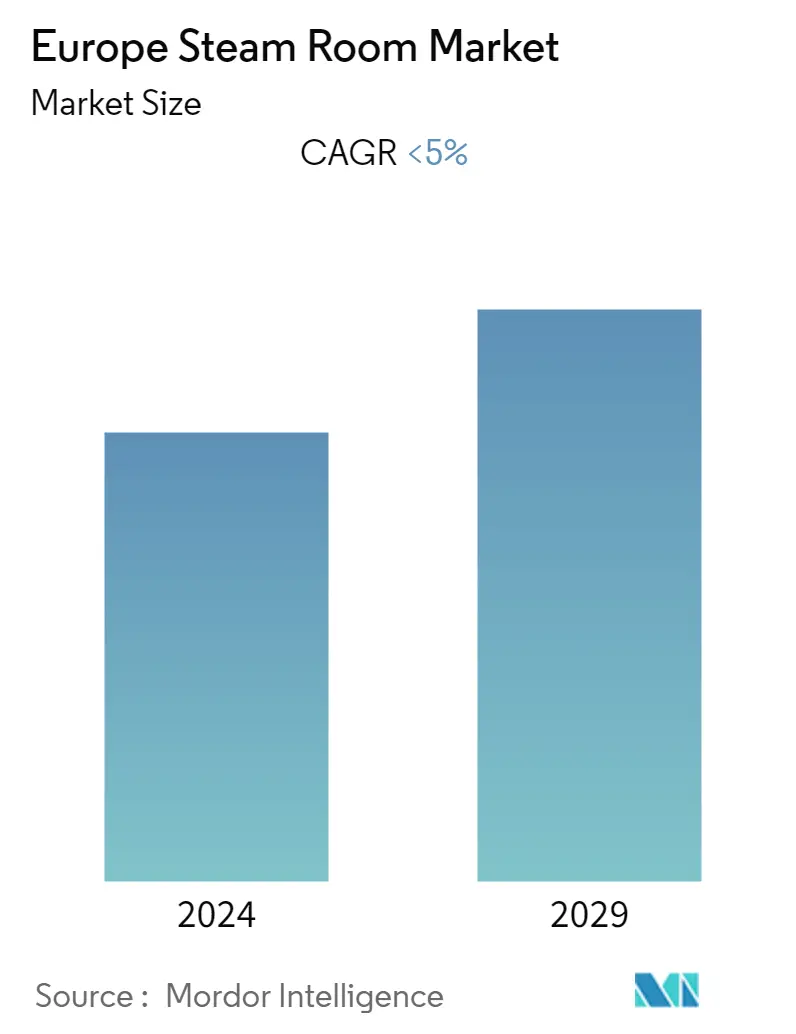Market Size of Europe Steam Room Industry

| Study Period | 2019 - 2029 |
| Base Year For Estimation | 2023 |
| Forecast Data Period | 2024 - 2029 |
| Historical Data Period | 2019 - 2022 |
| CAGR | < 5.00 % |
| Market Concentration | Medium |
Major Players_-_Copy.webp)
*Disclaimer: Major Players sorted in no particular order |
Europe Steam Room Market Analysis
The COVID-19 pandemic had a negative impact on gyms and spa services. However, after the easing of lockdown restrictions, the market experience growth, which may continue in the coming years with the introduction of new products and innovation.
People use hot steam rooms for leisure and to treat certain medical issues. They are frequently found in spas or gyms. A water-filled generator pumps steam into a small area, creating a steam chamber where people can sit and inhale moist air. Although the temperatures of steam rooms might fluctuate, steam rooms are normally kept at about 110°F. Saunas and steam rooms share similarities, as they both provide benefits to health. However, they differ in the type of heat they offer. Saunas use dry heat, typically from hot rocks or a closed burner.
Ancient Greek and Roman cultures were among the first to use steam rooms for bathing. Turkish baths in Europe also provide a similarly warm and humid environment for relaxation. Modern steam rooms are heated, enclosed areas that produce steam and are frequently used to promote relaxation and recovery after exercise. They are frequently heated at a lower temperature than typical saunas, between 40 °C and 50 °C. Steam rooms can be a better option for someone who finds the heat of a regular sauna a little too intense. Steam rooms can aid with relaxation, better skin health, and post-workout recuperation, among other things. Other advantages of taking a bath in a steam room include better heart health, maximized recovery after exercise, detoxifying results, reduced clogging, stress reduction and better sleep, pain and discomfort relief, and better blood circulation.
Europe Steam Room Industry Segmentation
Saunas and steam rooms share similarities. Both suggest that sitting in a small, warm space will be beneficial to your health. The type of heat they offer is where there is a significant difference. Dry heat, typically from hot rocks or a closed burner, is used in saunas. A generator that heats water to a rolling boil is used to heat steam.
The European Steam Room Market is Segmented by Type (Infrared and Conventional), End User (Residential and Commercial), and Country (Germany, United Kingdom, France, Italy, and the Rest of Europe). The report offers Market size and forecasts for Europe Steam Room Market in value (USD Million) for all the above segments.
| Type | |
| Infrared | |
| Conventional |
| End User | |
| Residential | |
| Commercial |
| Country | |
| Germany | |
| United Kingdom | |
| France | |
| Italy | |
| Rest of Europe |
Europe Steam Room Market Size Summary
The European steam room market is experiencing a resurgence following the challenges posed by the COVID-19 pandemic, which initially impacted gyms and spa services. As lockdown restrictions eased, the market began to grow, driven by innovations and new product introductions. Steam rooms, often found in spas and gyms, offer a unique environment for relaxation and health benefits, differing from saunas by providing moist heat. Historically rooted in ancient Greek and Roman cultures, modern steam rooms are designed to promote relaxation, recovery, and various health benefits, such as improved skin health and better blood circulation. The market is witnessing increased interest from millennials, who are prioritizing wellness and are willing to invest in lifestyle enhancements, thereby driving demand for steam room services.
The market landscape in Europe is highly fragmented, with established players facing increased competition from new entrants. Key industry players, including KLAFS Group, Harvia PLC, TyloHelo Oy, Duravit, and Physiotherm, are focusing on personalized services to attract a broader clientele. The market's growth is further supported by the expanding geriatric population and the rising popularity of gym and spa services among working professionals seeking to counteract the effects of sedentary lifestyles. Recent strategic moves, such as Harvia PLC's acquisition of a minority stake in EOS Group, highlight the dynamic nature of the market. Recognition of brands like KLAFS, which has received multiple "Brand of the Century" awards, underscores the competitive and evolving nature of the European steam room industry.
Europe Steam Room Market Size - Table of Contents
-
1. MARKET INSIGHTS AND DYNAMICS
-
1.1 Market Overview
-
1.2 Market Drivers
-
1.3 Market Restraints
-
1.4 Value Chain/Supply Chain Analysis
-
1.5 Porter's Five Forces Analysis
-
1.5.1 Threat of New Entrants
-
1.5.2 Bargaining Power of Buyers/Consumers
-
1.5.3 Bargaining Power of Suppliers
-
1.5.4 Threat of Substitute Products
-
1.5.5 Intensity of Competitive Rivalry
-
-
1.6 Insights on Latest Trends and Technological Innovations in the Industry
-
1.7 Impact of COVID-19 on the Market
-
-
2. MARKET SEGMENTATION
-
2.1 Type
-
2.1.1 Infrared
-
2.1.2 Conventional
-
-
2.2 End User
-
2.2.1 Residential
-
2.2.2 Commercial
-
-
2.3 Country
-
2.3.1 Germany
-
2.3.2 United Kingdom
-
2.3.3 France
-
2.3.4 Italy
-
2.3.5 Rest of Europe
-
-
Europe Steam Room Market Size FAQs
What is the current Europe Steam Room Market size?
The Europe Steam Room Market is projected to register a CAGR of less than 5% during the forecast period (2024-2029)
Who are the key players in Europe Steam Room Market?
KLAFS Group, Harvia PLC, TyloHelo Oy, Duravit, Physiotherm and Narvi Oy are the major companies operating in the Europe Steam Room Market.

